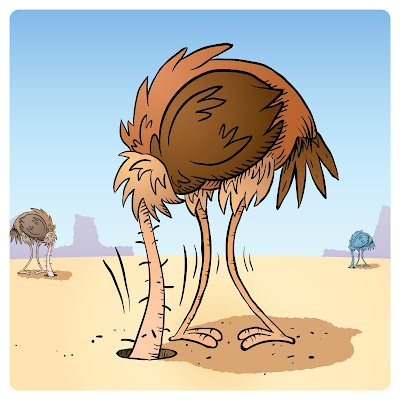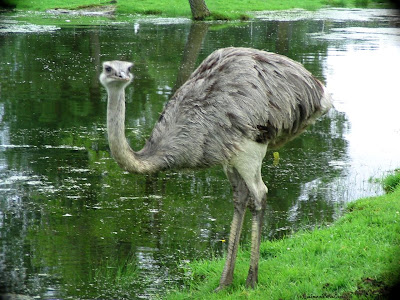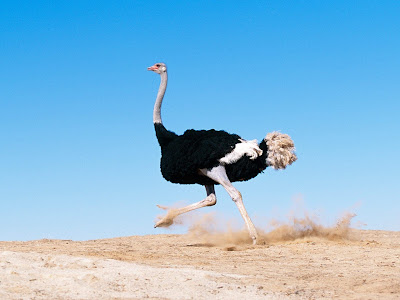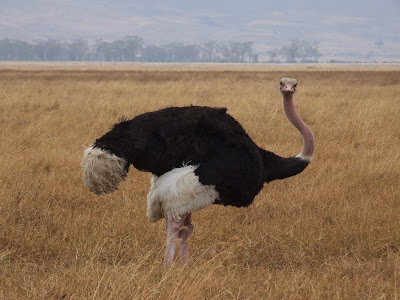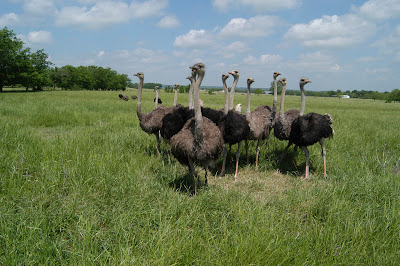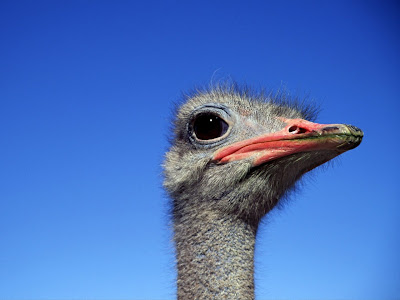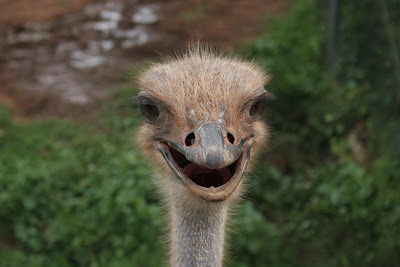The Ostrich, (Struthio camelus), is a large flightless bird native to Africa. It is the only living species of its family, Struthionidae and its genus, Struthio. Ostriches share the order Struthioniformes with the kiwis, emus, and other ratites. It is distinctive in its appearance, with a long neck and legs and the ability to run at maximum speeds of about 97.5 kilometres per hour (60.6 mph), the top land speed of any bird.The Ostrich is the largest living species of bird and lays the largest egg of any living bird (extinct elephant birds of Madagascar and the giant moa of New Zealand did lay larger eggs).
The diet of the Ostrich mainly consists of plant matter, though it also eats invertebrates. It lives in nomadic groups which contain between five and fifty birds. When threatened, the Ostrich will either hide itself by lying flat against the ground, or will run away. If cornered, it can attack with a kick from its powerful legs. Mating patterns differ by geographical region, but territorial males fight for a harem of two to seven females. These fights usually last just minutes, but they can easily cause death through slamming their heads into opponents.
The Ostrich is farmed around the world, particularly for its feathers, which are decorative and are also used as feather dusters. Its skin is used for leather products and its meat marketed commercially.
Ostriches usually weigh from 63 to 130 kilograms (140–290 lb), with exceptional male Ostriches weighing up to 155 kilograms (340 lb). The feathers of adult males are mostly black, with white primaries and a white tail. However, the tail of one subspecies is buff. Females and young males are greyish-brown and white. The head and neck of both male and female Ostriches is nearly bare, with a thin layer of down. The skin of the females neck and thighs is pinkish gray, while the male's is blue-gray, gray or pink dependent on subspecies.
The flightless ostrich is the world's largest bird. They roam African savanna and desert lands and get most of their water from the plants they eat.
Though they cannot fly, ostriches are fleet, strong runners. They can sprint up to 43 miles (70 kilometers) an hour and run over distance at 31 miles (50 kilometers) an hour. They may use their wings as "rudders" to help them change direction while running. An ostrich's powerful, long legs can cover 10 to 16 feet (3 to 5 meters) in a single stride. These legs can also be formidable weapons. Ostrich kicks can kill a human or a potential predator like a lion. Each two-toed foot has a long, sharp claw.
Ostriches live in small herds that typically contain less than a dozen birds. Alpha males maintain these herds, and mate with the group's dominant hen. The male sometimes mates with others in the group, and wandering males may also mate with lesser hens. All of the group's hens place their eggs in the dominant hen's nest though her own are given the prominent center place. The dominant hen and male take turns incubating the giant eggs, each one of which weighs as much as two dozen chicken eggs.
Contrary to popular belief, ostriches do not bury their heads in the sand. The old saw probably originates with one of the bird's defensive behaviors. At the approach of trouble, ostriches will lie low and press their long necks to the ground in an attempt to become less visible. Their plumage blends well with sandy soil and, from a distance, gives the appearance that they have buried their heads in the sand.
Ostriches typically eat plants, roots, and seeds but will also eat insects, lizards, or other creatures available in their sometimes harsh habitat.


